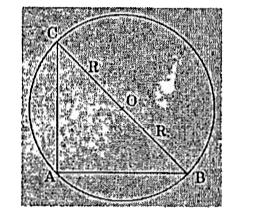An isosceles triangle of vertical angle 2θ is inscribed in a circle of radius a . Show that the area of the triangle is maximum when θ=π6 .
To solve the problem of maximizing the area of an isosceles triangle inscribed in a circle of radius a with a vertical angle 2θ, we will follow these steps:
Step 1: Understand the Geometry
We have a circle with radius a and an isosceles triangle ABC inscribed in it. The angle at vertex A is 2θ, and the angles at vertices B and C are each θ.
Step 2: Determine the Area of the Triangle
The area A of triangle ABC can be expressed in terms of the base BC and height AD (where D is the foot of the altitude from A to BC):
A=12×base×height
The base BC can be expressed as:
BC=2×AD
Using the sine rule, we can express the area in terms of a and θ:
A=12×a2×sin(2θ)=a2sin(θ)cos(θ)=a22sin(2θ)
Step 3: Differentiate the Area with Respect to θ
To find the maximum area, we need to differentiate A with respect to θ:
dAdθ=a22⋅2cos(2θ)=a2cos(2θ)
Step 4: Set the Derivative to Zero
To find the critical points, we set the derivative equal to zero:
a2cos(2θ)=0
This gives us:
cos(2θ)=0
The solutions to this equation are:
2θ=π2+nπ(n∈Z)
Thus:
θ=π4+nπ2
Step 5: Evaluate the Critical Points
The relevant solution in the context of the problem is:
θ=π4
However, we need to check for maximum area.
Step 6: Second Derivative Test
To confirm whether this critical point is a maximum, we compute the second derivative:
d2Adθ2=−2a2sin(2θ)
Evaluating at θ=π4:
d2Adθ2=−2a2sin(π2)=−2a2<0
This indicates that the area is maximized at θ=π4.
Step 7: Relate θ to the Given Condition
We need to show that the area is maximum when θ=π6. We find that:
2θ=π3
Thus, the maximum area occurs when:
θ=π6
Conclusion
The area of the triangle is maximized when θ=π6.
We have a circle with radius a and an isosceles triangle ABC inscribed in it. The angle at vertex A is 2θ, and the angles at vertices B and C are each θ.
The area A of triangle ABC can be expressed in terms of the base BC and height AD (where D is the foot of the altitude from A to BC):
A=12×base×height
The base BC can be expressed as:
BC=2×AD
Using the sine rule, we can express the area in terms of a and θ:
A=12×a2×sin(2θ)=a2sin(θ)cos(θ)=a22sin(2θ)
To find the maximum area, we need to differentiate A with respect to θ:
dAdθ=a22⋅2cos(2θ)=a2cos(2θ)
To find the critical points, we set the derivative equal to zero:
a2cos(2θ)=0
This gives us:
cos(2θ)=0
The solutions to this equation are:
2θ=π2+nπ(n∈Z)
Thus:
θ=π4+nπ2
The relevant solution in the context of the problem is:
θ=π4
However, we need to check for maximum area.
To confirm whether this critical point is a maximum, we compute the second derivative:
d2Adθ2=−2a2sin(2θ)
Evaluating at θ=π4:
d2Adθ2=−2a2sin(π2)=−2a2<0
This indicates that the area is maximized at θ=π4.
We need to show that the area is maximum when θ=π6. We find that:
2θ=π3
Thus, the maximum area occurs when:
θ=π6
The area of the triangle is maximized when θ=π6.
Similar Questions
Knowledge Check
Area of an equilateral triangle inscribed in a circle of radius a is
A√3a2/4Bπa2/3C3√3a2/4D√3πa2/4The triangle of maximum area that can be inscribed in a given circle of radius 'r' is
AAn isoscles triangle with base equal to 2rBAn equilateral of height 2r3Can equilateral trianlge having each of its side of length √3rDA right angle triangle having two of its sides of length 2r and r.If a triangle of maximum area is inscribed within a circle of radius R, then
 AS=2R2B1r1+1r2+1r3=√2+1RCr=(√2−1)RDs=(1+√2).2R
AS=2R2B1r1+1r2+1r3=√2+1RCr=(√2−1)RDs=(1+√2).2R
An equilateral triangle is inscribed in a circle of radius 'r' units. The area of shaded region is
View SolutionIf a triangle of maximum area is inscribed within a circle of radius R, then

View SolutionIf a triangle is inscribed in a circle of radius r , then which of the following triangle can have maximum area
View SolutionA right angled isosceles triangle is inscribed in a circle of radius r. What is the area of the remaining portion of the circle ?
View SolutionIf a right angled triangle ABC of maximum Δ area is inscribed in a circle of radius R , then
View Solution
